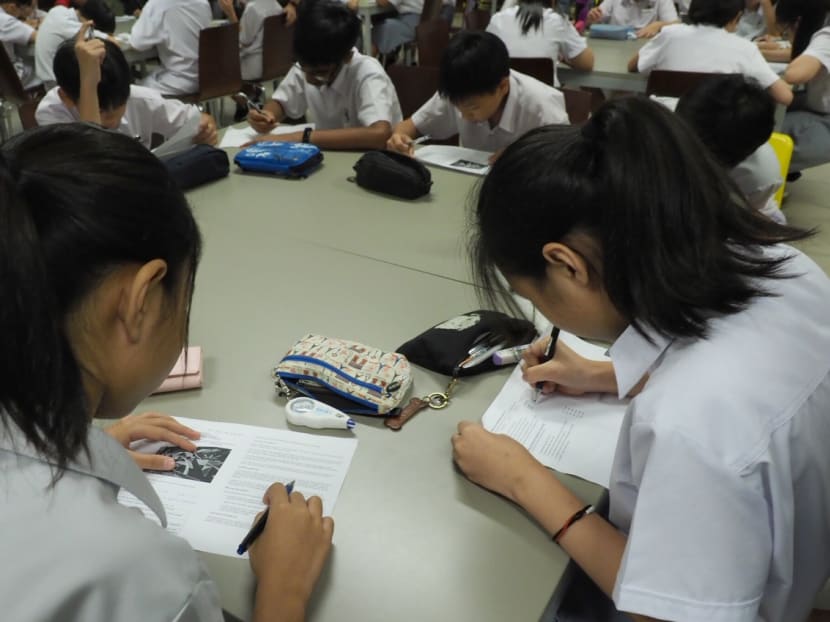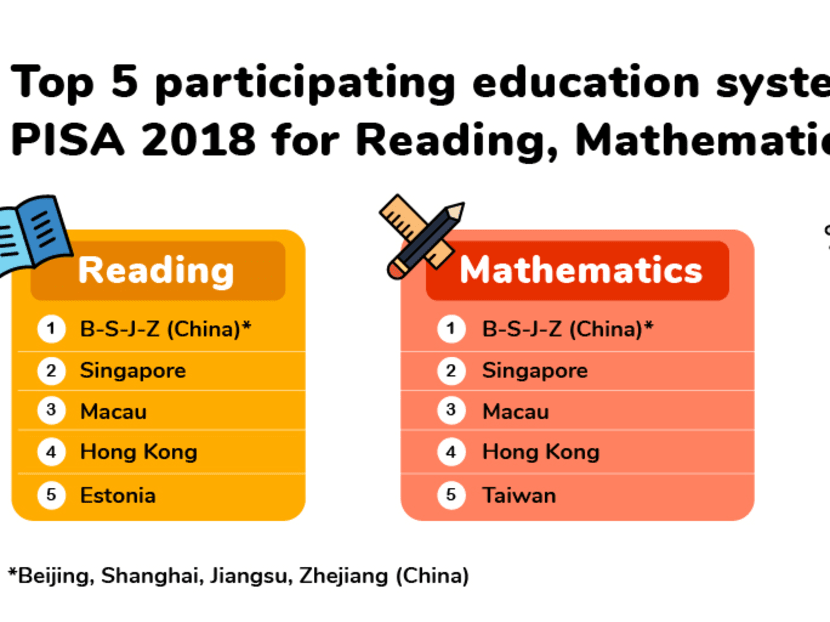China pips Singapore to top spots in Pisa test
SINGAPORE — Singapore lost its pole positions for reading, mathematics and science in an international test for 15-year-olds, despite its students maintaining a high performance across the three categories.

Singapore students maintained their scores across maths and science, and showed a marked improvement in reading.
SINGAPORE — Singapore lost its pole positions for reading, mathematics and science in an international test for 15-year-olds, despite its students maintaining a high performance across the three categories.
Results of the Programme for International Student Assessment (Pisa), an international scorecard for education systems around the world, were released on Tuesday (Dec 3) with Singapore students coming in second in the three areas, behind China.
Held every three years, the test is conducted by the Organisation for Economic Co-operation and Development (OECD) to evaluate the “quality, equity and efficiency of school systems”. The latest test was done last year.
In the previous test carried out in 2015, Singapore came out tops in all three categories.
The Pisa test evaluates 15-year-old students across 79 education systems, 37 from OECD member countries and 42 from non-member economies, on their ability to apply their knowledge and skills in reading, mathematics and science.
In Singapore, 6,676 students aged 15 participated in the study. The students came from all 153 public secondary schools and 13 randomly sampled private schools.
Each cycle of the test focuses on one particular category, with this year’s focus on reading. In 2015, science was the focus of the test.
OVERTAKEN BY CHINA
Singapore was edged out by China which was represented by students from Beijing, Shanghai, Jiangsu and Zhejiang.
Singapore registered a mean score of 549 for reading, 569 for mathematics and 551 for science, similar to its scores in 2015 of 535 for reading, 564 for mathematics and 556 for science.
In comparison, China outperformed the Republic, getting a mean score of 555 for reading, 591 for mathematics and 590 for science.

In the 2015 test, China — then represented by Beijing, Shanghai, Jiangsu and Guangdong — came in 27th in reading, 6th in mathematics and 10th in science.
In the 2012 test, however, China was represented by students from Shanghai and topped all three categories, while Singapore came in third for reading and science, and second for mathematics.
China had also topped the three categories for the 2009 cycle, with Singapore coming in fifth for reading, second for mathematics and fourth for science, the first time the Republic participated.
TODAY has asked OECD on why China again decided to change its participating cities for the test.
On China overtaking Singapore in the rankings, Mr Sng Chern Wei, deputy director-general of education (curriculum) in the Ministry of Education (MOE), said the ministry was “happy” that China is doing well.
“We didn’t take part in Pisa to try and beat every country. We try to take part in Pisa to learn important areas for improvement for ourselves and when other countries do well, we will continue to learn from them and try to make the educational experience and learning journey a more positive one and more effective one for our students,” he said.
Education Minister Ong Ye Kung in a Facebook post echoed this view.
"Doing well in international rankings is not our end goal. But such benchmarking is useful to gauge where we stand internationally, and to reflect on where we can improve, such as making education more holistic, inculcating greater joy for learning, and creating an environment where failure is more accepted," he wrote.
Education experts told TODAY there was no cause for concern over Singapore losing the top spots.
Dr Jason Tan, an associate professor for policy and leadership studies at the National Institute of Education, said that based on the Pisa results, Singapore students were still performing well.
He also noted that the four Chinese provinces which participated in the test were wealthy cities or coastal provinces and they were not representative of the whole of China.
Dr Timothy Chan, director of the academic division at SIM Global Education, said that Singapore should compare its latest results with its previous ones instead. “I’m not concerned that (Singapore) has slipped by one position… We are still improving and this shows we are in the right direction,” he said.
HIGHER THAN THE OECD AVERAGE
Despite the drop in rankings, Singapore continued to either maintain or improve its performance in each of the three categories.
The Republic’s score of 549 for reading, 569 for mathematics and 551 for science was significantly higher than the OECD average of 487 for reading, 489 for mathematics and 489 for science.
For mathematics, 93 per cent of students here scored at least level 2 in the test, significantly higher than the OECD average of 76 per cent. Students who achieve a proficiency of level 2 in mathematics can interpret and recognise how a simple situation can be represented mathematically, such as converting prices into a different currency.
Close to 40 per cent of students here also scored level 5 or higher for mathematics, higher than the OECD average of 11 per cent. Such students can model complex situations mathematically and evaluate the appropriate problem-solving strategies to deal with these situations.
When it came to science, 91 per cent of students in Singapore achieved level 2 or higher in science, higher than the OECD average of 78 per cent. At this level, students can recognise the correct explanation for scientific phenomena and in simple cases, identify if a conclusion is valid based on the data provided.
Twenty-one per cent of Singapore students achieved level 5 or 6 for science, three times more than the OECD average. At this level, students can “creatively and autonomously” apply their knowledge of science to a wide variety of situations.
Students from Singapore formed the largest proportion of top performers (26 per cent) — defined as those who achieve a proficiency level of 5 or 6 in the Pisa test — in the reading category.
In the mathematics category, 37 per cent of top performers came from Singapore — the second highest proportion in that category.
Singapore also had the second highest proportion of top performers (21 per cent) for the science category.
BIGGEST IMPROVEMENT IN READING
Of the three categories, Singapore saw the highest improvement in reading, jumping 14 points from the test in 2015.
Eighty-nine per cent of students here attained at least a level 2 proficiency in reading compared to the OECD country average of 77 per cent.
At level 2 proficiency, students can identify the main idea in a text of moderate length, find information based on explicit criteria. They can also reflect on the purpose and form of texts when explicitly directed to do so.
The Education Ministry attributed the improved scores in reading in part to the increase in proportion of 15-year-old students coming from English-speaking homes.
Close to 60 per cent of students in 2018 were from English-speaking homes, an increase from about 50 per cent in 2015.
The ministry also said that the education system here provides a strong literacy foundation in primary schools.
For instance, the Strategies for English Language Learning and Reading (Stellar) programme strengthens the language and reading skills of primary school students by incorporating storytelling and role-playing into lessons.
Meanwhile, secondary schools run programmes to improve the reading skills of students. For example, Edgefield Secondary School has an intensive reading programme conducted weekly or fortnightly.
However, the Pisa test also found that while Singapore students enjoyed reading more than their OECD peers, they enjoyed it less compared to Singapore students surveyed in 2009.
For instance, 49 per cent of Singapore students said reading was a hobby in the latest test, down from 54 per cent in 2009. Forty-six per cent of Singapore students also said they read only if they had to, up from 35 per cent in 2009.
There was also a similar decline in enjoyment of reading observed across other OECD countries.
The MOE attributed the decline possibly to students spending more time on social media and added that it will continue to encourage students to read more widely and for leisure.
Dr Chan felt that the decline in enjoyment was due to a growing “digital lifestyle” among young students where they are connected to the Internet through various devices such as their mobile phones or tablets.
He noted that on these devices, information is presented in various forms including video and animation. As such, students may prefer to consume information through such formats.
To create joy in reading, Dr Chan suggested more engaging ways for students to use text. For example, they could be asked to look for news articles published online and present these in class using a variety of formats. “It will give the student a sense of ownership, having found the article or information himself,” said Dr Chan.
STUDENTS FROM DISADVANTAGED BACKGROUNDS DO BETTER THAN OECD PEERS
Singapore students from the bottom quarter socio-economic status (SES) also continued to perform well in the Pisa tests, scoring better than their low-SES peers from other countries.
Students from the 25th percentile SES here scored 495 for reading, 520 for mathematics and 501 for science. In comparison, the OECD average for students from similar economic backgrounds was 445 (reading), 448 (mathematics) and 447 (science).
In fact, the test found that students from the bottom quarter here scored better than the overall OECD average for all three categories.
The survey also found that low-performing students here were less clustered in specific schools compared to other OECD countries.
Mr Ong said: "Latest results showed that Singapore maintained high standards in reading, maths and science… We are particularly happy that our students, including those from less well-off homes, continue to do well."








